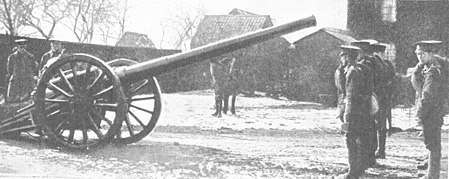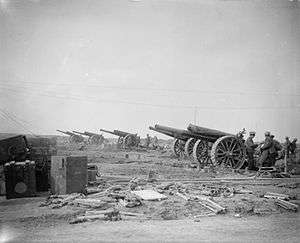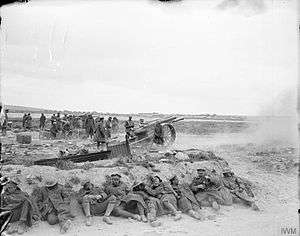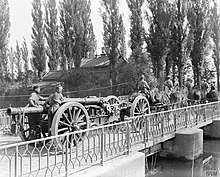1st Carnarvonshire Artillery Volunteers
The 1st Carnarvonshire Artillery Volunteers was a part-time unit of the British Army in North Wales from 1862 to 1922. It fought on the Western Front in World War I. Postwar it was amalgamated with the Denbighshire Hussars as a medium artillery regiment that served in World War II.
| 1st Carnarvonshire Artillery Volunteers 1st Carnarvonshire RGA (V) Welsh (Carnarvonshire) Heavy Battery, RGA | |
|---|---|
| Active | 12 March 1862 – 1 March 1922 |
| Country | |
| Branch | Territorial Force |
| Role | Garrison artillery Heavy artillery |
| Part of | 53rd (Welsh) Division |
| Garrison/HQ | Caernarfon Bangor, Gwynedd |
| Engagements | Western Front (World War I) |
Volunteer Force
The enthusiasm for the Volunteer movement following an invasion scare in 1859 saw the creation of many Volunteer Corps composed of part-time soldiers eager to supplement the Regular British Army in time of need.[1][2][3] One such unit was the 1st Carnarvonshire Artillery Volunteer Corps[lower-alpha 1] raised at Carnarvon on 12 March 1862.[4][5] It was a small unit (51 strong in 1871), and for most of the 1860s and 1870s only had one officer, Captain William Turner, commissioned on 13 August 1864, and later Sub-Lieutenant William Owen, commissioned on 20 June 1874.[5][6] In 1863 it joined the 1st Administrative Brigade of Anglesey Artillery Volunteer Corps (AVCs). However, Volunteer recruitment in Anglesey declined and in 1873 the remaining Anglesey and Carnarvon AVCs were transferred to the Administrative Brigade in Cheshire This was consolidated as the 1st Cheshire and Carnarvonshire Artillery Volunteer Corps in 1880, with 1st Carnarvon AVC providing No 8 Company.[5][6][7]
In 1882 the 1st Cheshire and Carnarvonshire was assigned to the Lancashire Division of the Royal Artillery, but when the divisional structure was reduced in 1889 it joined the Southern Division. On 1 June 1899 all the Volunteer artillery units became part of the Royal Garrison Artillery (RGA) and from 1902 the unit became the 1st Cheshire and Carnarvonshire RGA (Volunteers). However, in 1904 the Carnarvonshire batteries were withdrawn to form a separate unit, the 1st Carnarvonshire RGA (V) of four companies under the command of Lieutenant-Colonel Hugh Savage, VD, with the following organisation:[5][6][7]
- Headquarters at Glynne Road, Bangor[8][9]
- No 1 Company at Bangor, formed from part of No 6 Company
- No 2 Company at Llanfairfechan, formed from part of No 6 Company
- No 3 Company at University College of North Wales, Bangor, formerly No 7 Company
- No 4 Company at Carnarvon and Penygroes, formerly No 8 Company
Territorial Force

When the Volunteer Force was subsumed into the new Territorial Force (TF) under the Haldane Reforms of 1908,[10][11] the 1st Carnarvonshire RGA (V) became the Welsh (Carnarvonshire) RGA, with its HQ at Bangor and a dedicated Ammunition Column at Agyll Road, Llandudno.[9][12] The former No 3 Company at Bangor College transferred to the Officers' Training Corps.[5][6][7][13] The new unit provided the heavy battery in the TF's Welsh Division, equipped with four 4.7-inch guns.[14][15]
World War I
Mobilisation
The units of the Welsh Division had just departed for their annual summer camp when the order to mobilise was received on 4 August 1914. They then returned home and assembled at their drill halls to mobilise. The Welsh (Carnarvonshire) Heavy Battery mobilised at Bangor under the command of Major W.H. Hughes, who had held the command since 20 December 1913.[6][14][16][17][18]
By 11 August the Welsh units had completed their concentration and TF members were invited to volunteer for Overseas Service. Four days later the War Office (WO) issued instructions to separate those men who had signed up for Home Service only, and form these into reserve units. Then on 31 August the formation of a reserve or 2nd Line unit was authorised for each 1st Line unit where 60 per cent or more of the men had volunteered for Overseas Service. The titles of these 2nd Line units would be the same as the original, but distinguished by a '2/' prefix. In this way duplicate batteries, brigades and divisions were created, mirroring those TF formations being sent overseas.[14][16][19]
1/1st Welsh (Carnarvonshire) Heavy Battery
At the end of August the Welsh Division concentrated at Northampton to continue its training. On 18 November the division was warned for garrison duty in India, but this was cancelled and in December it moved to Cambridge, then to Bedford in May 1915. In July the infantry of the division (now renamed the 53rd (Welsh) Division) embarked for service at Gallipoli, leaving the divisional artillery behind in Bedford. On 20 November the divisional field artillery left to join the British Expeditionary Force (BEF) on the Western Front, but the heavy battery remained at Bedford. with the 2nd Line Welsh Division (now numbered as the 68th (2nd Welsh) Division).[14][16][18][20]
Finally, on 16 February 1916 the battery went to Woolwich to mobilise for overseas service with the BEF. It embarked at Southampton on 2 March, landing at Le Havre the following day, and joined 23rd Heavy Artillery Group (HAG) in Third Army. It went into action on 17 March.[14][16][18][21]<[22][23]
Somme
At the time the policy was to move RGA batteries from one HAG to another as required. 1/1st Welsh Hvy Bty moved to 6th HAG in First Army on 26 June, then to 17th HAG with Fourth Army on 29 July, when it joined the Battle of the Somme. At the end of that campaign the battery was transferred to 32nd HAG in Fifth Army on 2 December, then to 56th HAG on 19 February 1917.[14][22][23][24]
The obsolescent 4.7-inch guns were progressively replaced in the BEF by 60-pounders during 1916. In December 1916 the WO decided that all heavy batteries should be composed of six guns and 1/1st Welsh Hvy Bty was brought up to that strength on 7 March 1917 when it was joined by a section of 201st Hvy Bty (newly arrived in France and immediately broken up).[22][25]
Vimy Ridge

After this reorganisation, 1/1st Welsh Hvy Bty joined 31st HAG in First Army on 11 March.[22][23] On 20 March the artillery preparation began for the Battle of Vimy Ridge, with the batteries of 31st HAG firing from around Bully Grenay on the extreme north flank of the attack, from where they could virtually enfilade the German lines in support of I Corps. The artillery plan for the heavy guns emphasised counter-battery fire. At Zero hour, while the field guns laid down a Creeping barrage to protect the advancing infantry, the 60-pounders switched to 'searching' fire on the German rear areas to catch machine gunners and moving infantry. When the British infantry reached their Phase 2 objective (the Blue Line) the field guns would move forward and the 60-pounders move up to occupy their vacated positions. The attack went in on 9 April with I Corps and Canadian Corps successfully capturing Vimy Ridge while Third Army attacked further south near Arras. The only hold-up on 9 April was at Hill 145, near the north end of the Canadian attack, and the capture of this position was completed the next day. Fighting in the southern sector (the Battle of Arras) continued into May.[26][27][28]
1/1st Welsh Hvy Bty came under the command of 15th HAG on 11 May 1917 and moved to 67th HAG on 4 July, while First Army carried out a number of operations round Oppy Wood and Hill 70. Then on 23 October it moved to 11th HAG with Second Army, which was engaged in the final actions of the Battle of Passchendaele.[22][23][28][29]
Spring Offensive

Second Army HQ was sent to the Italian Front at the end of 1917, and Fourth Army took over the Ypres Salient, with 1/1st Welsh Hvy Bty transferring to 53rd HAG on 18 December.[22][23][24] By now HAG allocations were becoming more fixed, and on 1 February 1918 the HAGs were converted into permanent RGA brigades, with 53rd becoming a 'Mixed' brigade of 60-pounders and batteries of various calibres of howitzers.[30]
Second Army HQ resumed command of the Ypres sector (including 53rd (Mixed) Bde RGA), in March 1918 and was soon involved in the Battle of the Lys, the second phase of the German Spring Offensive that involved great loss of ground and rapid retreat for much of the artillery. The German advance on Second Army's front was halted on 29 April.[23][24][29][31]
Hundred Days

1/1st Welsh Hvy Bty received an extended rest from 27 July to 17 August.[22] Next day Second Army joined in the Allies' Hundred Days Offensive with the capture of several important ridges, and then a succession of attacks in early September. Second Army's contribution to the great series of coordinated offensives starting on 28 September was the Fifth Battle of Ypres (28 September–2 October).[29]
53rd Brigade including 1/1st Welsh Hvy Bty switched to First Army on 2 October and remained with it until the Armistice with Germany, including the Battle of the Selle, when it was under the command of VIII Corps to support XXII Corps crossing of the Echaillon and advance to the Schelde, and the Battle of the Sambre.[23][30][32][33]
The battery was placed in suspended animation in 1919.[13]
2/1st Welsh (Carnarvonshire) Heavy Battery
The 2nd Line unit was raised in 1914 and joined the 68th (2nd Welsh) Division, which concentrated at Northampton in April 1915. It moved to Bedford in the summer to replace the 53rd (Welsh) Division. Training of the units was made difficult by the lack of arms and equipment, although a trickle of horses and saddlery and later some obsolete guns reached the division during the year.[20]
68th (2nd Welsh) Division was now assigned a role in Home Defence and joined First Army (Home Forces) in Central Force, with its units quartered across Eastern England. In May 1917 it transferred to Northern Army (Home Forces), and the heavy battery was stationed at Leiston during the summer before moving into winter quarters at Blythburgh.[20]
2/1st Welsh (Carnarvonshire) Bty remained with 68th Division, supplying drafts to units overseas, until May 1918 when it joined 227th Mixed Brigade. It remained stationed at Blythburgh with four old 4.7-inch guns until the end of the war.[20][34] It was disbanded in 1919.[13]
Postwar
When the TF was reformed in 1920, the Welsh (Carnarvonshire) RGA was initially reformed as 12th (Carnarvon and Denbigh) Medium Brigade, RGA, which was to have had its HQ and two batteries at Colwyn Bay and one battery at Bangor. When the TF was reconstituted as the Territorial Army (TA) the following year the unit was redesignated 61st Medium Brigade, RGA, with probably only one battery (241 Medium Bty) at Bangor.[13][7]
However, wartime experience showed that the army had too many mounted units, and only the 14 most senior Yeomanry Cavalry regiments in the TA were retained as horsed cavalry, the remainder being converted to armoured cars or artillery. On 1 March 1922 the Denbighshire Hussars were merged with the new medium brigade to form 61st (Carnarvon & Denbigh Yeomanry) Medium Brigade, RGA with the following organisation:[6][7][13][35][36]
- HQ at Drill Hall, Colwyn Bay
- 241 (Carnarvon) Medium Bty at Bangor, from 61st Medium Bde
- 242 (Carnarvon) Medium Bty at Llandudo, from Denbighshire Hussars
- 243 (Denbigh) Medium Bty at Colwyn Bay, from Denbighshire Hussars
- 244 (Denbigh) Medium Bty at Wrexham from Denbighshire Hussars
The commanding officer (CO) was Acting Lt-Col W.F. Christian, DSO of the RGA, with Major W.H. Hughes (the Welsh Heavy Battery's prewar CO) as senior major. No prewar officers of the Denbigh Yeomanry were carried over to the new brigade.[6]
241 (Carnarvon) Medium Battery
When the TA was doubled in size just before World War II, 241 Medium Bty transferred to 69th (Carnarvon & Denbigh Yeomanry) Medium Regiment, which served in the Battle of France, the Middle East, Italy and North West Europe. After the war the regiment underwent a number of amalgamations until in 1967 it became Q (Denbighshire and Caernarvonshire Yeomanry) Bty in the Flintshire and Denbighshire Yeomanry, RA. In 1971 it was reformed as infantry, forming B (Flintshire and Denbighshire Yeomanry) Company in 3rd Battalion, Royal Welsh Fusiliers. The Denbighshire Yeomanry lineage was discontinued from 1999 to 2013, when a new 398 (Flintshire & Denbighshire Yeomanry) Transport Squadron, Royal Logistics Corps, was formed in the Army Reserve.[13][35][37]
Memorial
There is a memorial to the 1/1st Welsh (Caernarvon) Bty, RGA, alongside the main City of Bangor war memorial in the memorial gardens at Deiniol Road, Bangor. The flat lead panel carries 37 names of men who died in World War I and 27 from World War II. It was previously at Bangor Crematorium, and before that at the TA Drill Hall in Glynne Road, Bangor.[38]
Footnotes
- The contemporary spelling in all formal documents was 'Carnarvon', not 'Caernarvon', or today's preferred 'Caernarfon'.
Notes
- Beckett.
- Litchfield & Westlake, pp. 1–3.
- Spiers, pp. 163–8.
- Beckett, Appendix VIII.
- Litchfield & Westlake, pp. 38–9.
- Army List, various dates.
- "Carnarvon and Anglesey Artillery Volunteers at Regimentsor". Archived from the original on 27 December 2005. Retrieved 27 December 2005.
- Bangor at Drill Hall Project.
- Cernarvonshire at Great War Centenary Drill Halls.
- Dunlop, Chapter 14.
- Spiers, Chapter 10.
- Llandudno at Drill Hall Project.
- Litchfield pp. 27–8.
- Becke, Pt 2a, pp. 117–23.
- Conrad 1914.
- 53rd (W) Division at Long, Long Trail.
- TF RGA at Regimental Warpath.
- "53 (W) Division at Regimental Warpath". Archived from the original on 14 November 2009. Retrieved 14 November 2009.
- Becke, Pt 2b, p. 6.
- Becke, Pt 2b, pp. 83–90.
- RGA Heavy Btys at Long, Long Trail.
- 'Allocation of Heavy Batteries RGA', The National Archives (TNA), Kew, file WO 95/5494/2.
- 'Allocation of HA Groups', TNA file WO 95/5494/1.
- Becke, Pt 4, pp. 102–7.
- Farndale, Western Front, Annex E
- Farndale, Western Front, pp. 164–6, 174–6, Map 23.
- Cave, pp. 119–27, Map p. 121.
- Becke, Pt 4, pp. 74–8.
- Becke, Pt 4, pp. 82–7.
- Farndale, Western Front, Annex M.
- Blaxland, pp. 17–24.
- Edmonds & Maxwell-Hyslop, pp. 380–3.
- Farndale, Western Front, pp. 313-4.
- Farndale, Forgotten Fronts, Annex 7.
- "Denbighshire Yeomanry at Regiments.org". Archived from the original on 5 January 2006. Retrieved 5 January 2006.
- Litchfield, Appendix VII.
- Deesite.com 20 November 1013.
- IWM WMR Ref 17386.
Reference
- Maj A.F. Becke, History of the Great War: Order of Battle of Divisions, Part 2a: The Territorial Force Mounted Divisions and the 1st-Line Territorial Force Divisions (42–56), London: HM Stationery Office, 1935/Uckfield: Naval & Military Press, 2007, ISBN 1-847347-39-8.
- Maj A.F. Becke, History of the Great War: Order of Battle of Divisions, Part 2b: The 2nd-Line Territorial Force Divisions (57th–69th), with the Home-Service Divisions (71st–73rd) and 74th and 75th Divisions, London: HM Stationery Office, 1937/Uckfield: Naval & Military Press, 2007, ISBN 1-847347-39-8.
- Maj A.F. Becke, History of the Great War: Order of Battle of Divisions, Part 4: The Army Council, GHQs, Armies, and Corps 1914–1918, London: HM Stationery Office, 1944/Uckfield: Naval & Military Press, 2007, ISBN 1-847347-43-6.
- Ian F.W. Beckett, Riflemen Form: A Study of the Rifle Volunteer Movement 1859–1908, Aldershot: Ogilby Trusts, 1982, ISBN 0 85936 271 X.
- Gregory Blaxland, Amiens: 1918, London: Frederick Muller, 1968/Star, 1981, ISBN 0-352-30833-8.
- Nigel Cave, Battleground Europe: Arras: Vimy Ridge, Barnsley: Leo Cooper, 1996, ISBN 0-85052-399-0.
- Col John K. Dunlop, The Development of the British Army 1899–1914, London: Methuen, 1938.
- Brig-Gen Sir James E. Edmonds & Lt-Col R. Maxwell-Hyslop, History of the Great War: Military Operations, France and Belgium 1918, Vol V, 26th September–11th November, The Advance to Victory, London: HM Stationery Office, 1947/Imperial War Museum and Battery Press, 1993, ISBN 1-870423-06-2.
- Gen Sir Martin Farndale, History of the Royal Regiment of Artillery: Western Front 1914–18, Woolwich: Royal Artillery Institution, 1986, ISBN 1-870114-00-0.
- Gen Sir Martin Farndale, History of the Royal Regiment of Artillery: The Forgotten Fronts and the Home Base 1914–18, Woolwich: Royal Artillery Institution, 1988, ISBN 1-870114-05-1.
- Norman E.H. Litchfield, The Territorial Artillery 1908–1988 (Their Lineage, Uniforms and Badges), Nottingham: Sherwood Press, 1992, ISBN 0-9508205-2-0.
- Norman Litchfield & Ray Westlake, The Volunteer Artillery 1859–1908 (Their Lineage, Uniforms and Badges), Nottingham: Sherwood Press, 1982, ISBN 0-9508205-0-4.
- Edward M. Spiers, The Army and Society 1815–1914, London: Longmans, 1980, ISBN 0-582-48565-7.
External sources
- Mark Conrad, The British Army, 1914 (archive site)
- The Drill Hall Project
- Great War Centenary Drill Halls.
- Imperial War Museum, War Memorials Register
- The Long, Long Trail
- The Regimental Warpath 1914–1918 (archive site)
- Land Forces of Britain, the Empire and Commonwealth – Regiments.org (archive site)